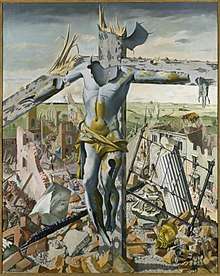Robert Henderson Blyth
Robert Henderson Blyth RSW RSA (21 May 1919-18 May 1970) was a Scottish landscape painter and artist.[1][2]
Robert Henderson Blyth | |
|---|---|
| Born | 21 May 1919 |
| Died | 18 May 1970 (aged 50) Aberdeen |
| Nationality | Scottish |
| Education | Glasgow School of Art |
| Known for | Painting |
Life and work

Blyth was born in the Newlands area of Glasgow and studied at the Glasgow School of Art from 1934 to 1939.[3][4] Blyth joined the Royal Army Medical Corps in 1941 and served with them until the end of the Second World War. During the war Blyth continued to paint and sketch, whilst on active service in France, Belgium, the Netherlands and Germany.[5] Four paintings from this period were acquired by the War Artists' Advisory Committee.[6] Towards the end of the conflict Blyth's unit, 157 Ambulance, was based in Hamburg much of which had been devastated by RAF bombing raids in 1943. Blyth used the background of a destroyed city in his most famous painting, In the Image of Man. Painted after the war ended the painting's title parodies the Judeo-Christian concept of man made in the image of God and shows a city in ruins behind a bomb damaged crucifix.[7] In 1945 Blyth won the Guthrie Award from the Royal Scottish Academy.[5][4] In 1946 he painted Existence Precarious, a self-portrait as a soldier in a trench, which is now in the National Gallery of Scotland. Also in 1946 he began teaching at the Edinburgh School of Art and became an artist in residence at Hospitalfield House. In 1954 he moved to Aberdeen to take a post at Gray's School of Art, where he became head of drawing in 1960, a post he maintained until his death in 1970.[8][9] The Scottish Arts Council organised a memorial exhibition to Blyth which toured Scotland during 1972. [10]
Memberships
- Associate Royal Scottish Academy, 1949
- Member Society of Scottish Artists, 1949
- Member Royal Scottish Society of Painters in Watercolour, 1949,
- Member Royal Scottish Academy, 1958.[5]
References
- David Buckman (1998). Artists in Britain Since 1945 Vol 1, A to L. Art Dictionaries Ltd. ISBN 0 95326 095 X.
- Grant M. Waters (1975). Dictionary of British Artists Working 1900-1950. Eastbourne Fine Art.CS1 maint: uses authors parameter (link)
- Royal Scottish Academy. "Images for Scottish Art, Robert Henderson Blyth". Royal Scottish Academy. Archived from the original on 2 July 2013. Retrieved 16 June 2014.
- Benezit Dictionary of Artists Volume 2 Bedeschini-Bulow. Editions Grund, Paris. 2006. ISBN 2 7000 3072 9.
- Peter J.M. McEwan (1994). The Dictionary of Scottish Art and Architecture. Antique Collectors' Club. ISBN 1 85149 134 1.
- Imperial War Museum. "War artists archive, R Henderson Blyth". Imperial War Museum. Retrieved 16 June 2014.
- Art from the Second World War. Imperial War Museum. 2007. ISBN 978-1-904897-66-8.
- Paul Harris & Julian Halsby (1990). The Dictionary of Scottish Painters 1600 to the Present. Canongate. ISBN 1 84195 150 1.
- The Gazetter for Scotland. "Robert Henderson Blyth". The Gazetter for Scotland. Retrieved 16 June 2014.
- Yale Center for British Art. "Blyth, Robert Henderson 1919-1970". Yale Center for British Art. Retrieved 16 June 2014.
External links
| Wikimedia Commons has media related to Robert Henderson Blyth. |